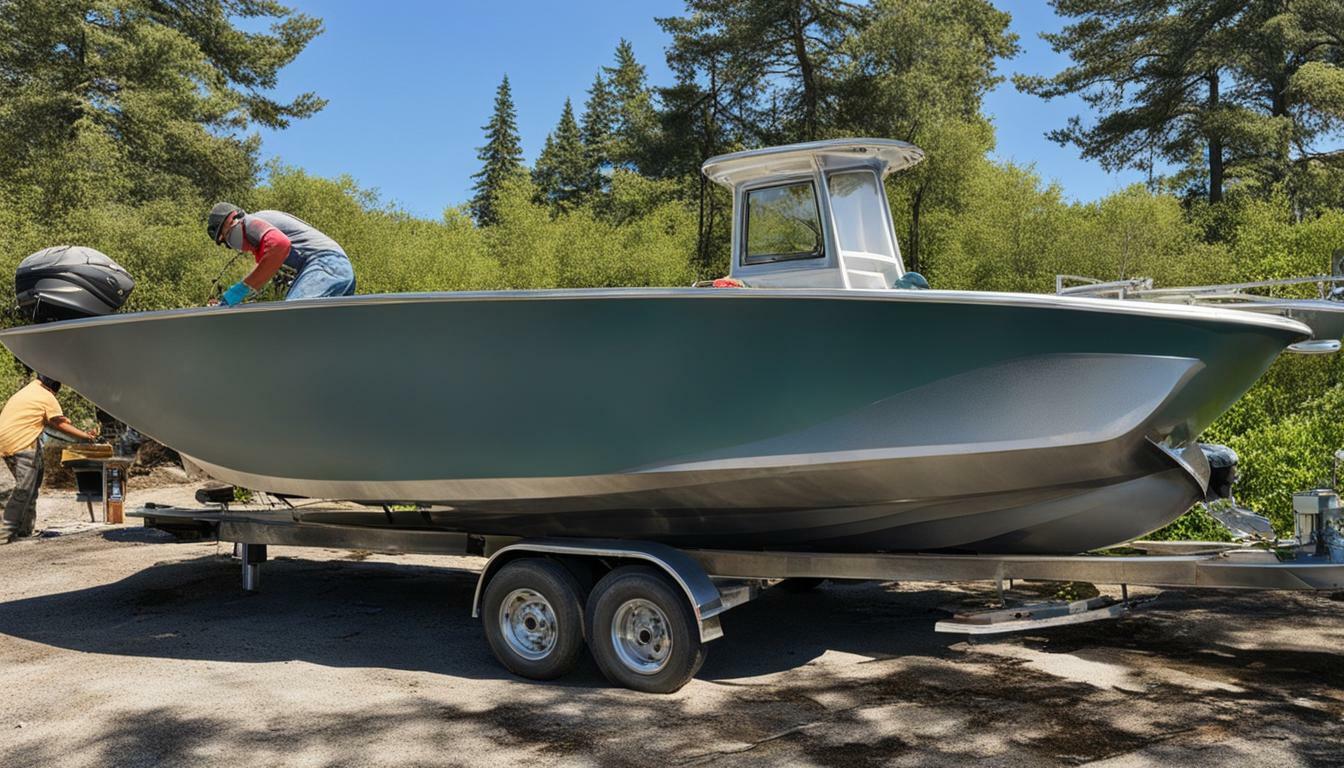Painting an aluminum boat can breathe new life into a well-used and neglected vessel. However, finding reliable information on how to paint an aluminum boat can be difficult. This comprehensive step-by-step guide will provide you with the necessary information and materials to successfully paint your aluminum boat.
Note: We stick to the term “aluminum”. For our european readers its “aluminium” of course.
Boat Preparation
Before diving into the painting process, it is important to inspect the boat for functionality and make any necessary repairs. Look for corrosion, cracks, and holes, especially along the keel and strakes. Use products like JB Weld or flex tape to repair any damage. Replace rusted bolts or bad rivets to ensure the boat is structurally sound for the paint job.
Materials you’ll need
To achieve a professional-looking paint job without breaking the bank, you’ll need the following materials:
- Citristrip Striping Gel (1-2 quarts)
- Bristle or foam brushes (2-3 inch)
- Protective gloves
- Eye and ear protection
- Face mask or respirator
- Plastic or metal scraper
- Wire wheel
- Electric power drill
- Fine steel wool
- Sanding blocks (180 grit and finer)
- Frog tape
- Butcher or craft masking paper
- Scissors
- Drop cloths
- Plastic bags or plastic drop cloth
- Clean rags
- Low odor Mineral Spirits
- Aluminum self etching primer (4 spray cans for bare aluminum)
- Outdoor safe protective enamel or similar paint for exterior (4-6 spray cans)
- Outdoor safe textured paint for interior (4-6 spray cans)
- UV protective clear coat (2 spray cans)
The quantity listed is for a 12-foot boat, so adjust accordingly for larger or smaller vessels. The estimated cost for all the materials ranges from $150 to $200, depending on the boat’s size and the paint used.
Getting Started
Finding the right time and space for your painting project is crucial. Choose a dry location, preferably a garage, where you can work without being affected by weather conditions. Ensure that the temperature is within the range of 50° to 90° Fahrenheit, as specified for painting with spray cans.
Step 1: Apply paint stripper
Using a paint stripper is an essential step in achieving a smooth and clean surface for the new paint to adhere to. Citristrip stripping gel is a recommended product for removing old paint from aluminum boats. Apply the gel generously with a brush, keeping the sections manageable. Cover the gel with plastic to prevent drying out. Let it sit for 2 to 4 hours before scraping off the old paint.
Step 2: Remove stubborn paint
For areas where the paint is stubborn, reapply another layer of stripping gel. In difficult-to-reach spots and seams, use a wire wheel attached to an electric drill to remove the paint. Be cautious not to exert excessive pressure, as it may cause minor pitting on the aluminum.
Step 3: Clean the hull
After removing the old paint, it is crucial to thoroughly clean the hull. This can be done by using an aluminum cleaner or a mixture of warm water and soap. Ensure that any dirt, grease, corrosion, or adhesives are completely removed from the hull. Rinse off the cleaner and let the hull dry completely before proceeding to the next steps.
Step 4: Sanding
To prepare the surface for painting, sand the entire boat, roughing up the old paint and smoothing out any rough patches on the bare aluminum. Use sandpaper with a grit of 180 or finer, sanding in one direction. You may also use a sander with a wire wheel for difficult spots. After sanding, clean the hull once again to remove any dust or particles.
Step 5: Priming and Step 6: Painting
Priming is a crucial step to ensure paint adhesion and durability. While some suggest that the old paint does not need to be primed if sanded properly, it is recommended to use a self-etching primer on the bare aluminum surfaces. Once the primer is applied, it’s time to paint the aluminum boat. Spray cans are a popular choice for convenience and cost-effectiveness. Apply an outdoor-safe protective enamel or similar paint for the exterior, and an outdoor-safe textured paint for the interior. Finish the paint job with a UV protective clear coat for added durability and protection against the elements.
Conclusion
By following these step-by-step instructions and using the recommended materials, you can successfully paint your aluminum boat and give it a fresh, new look. Remember to take your time, ensure proper boat preparation, and consistently follow best practices for each step to achieve the best results.
Key Takeaways
- Inspect the boat for functionality and make any necessary repairs before painting
- Thoroughly clean the hull and sand it before priming and painting
- Use self-etching primer on the bare aluminum surfaces to ensure paint adhesion and durability
Boat Preparation:
Before diving into the painting process, it is important to inspect the boat for functionality and make any necessary repairs. Look for corrosion, cracks, and holes, especially along the keel and strakes. Use products like JB Weld or flex tape to repair any damage. Replace rusted bolts or bad rivets to ensure the boat is structurally sound for the paint job.
Materials you’ll need:
To achieve a professional-looking paint job without breaking the bank, you’ll need the following materials:
| Product | Quantity |
|---|---|
| Citristrip Striping Gel | 1-2 quarts |
| Bristle or foam brushes | 2-3 inch |
| Protective gloves | |
| Eye and ear protection | |
| Face mask or respirator | |
| Plastic or metal scraper | |
| Wire wheel | |
| Electric power drill | |
| Fine steel wool | |
| Sanding blocks (180 grit and finer) | |
| Frog tape | |
| Butcher or craft masking paper | |
| Scissors | |
| Drop cloths | |
| Plastic bags or plastic drop cloth | |
| Clean rags | |
| Low odor Mineral Spirits | |
| Aluminum self etching primer | 4 spray cans for bare aluminum |
| Outdoor safe protective enamel or similar paint for exterior | 4-6 spray cans |
| Outdoor safe textured paint for interior | 4-6 spray cans |
| UV protective clear coat | 2 spray cans |
The quantity listed is for a 12-foot boat, so adjust accordingly for larger or smaller vessels. The estimated cost for all the materials ranges from $150 to $200, depending on the boat’s size and the paint used.
Getting Started:
Finding the right time and space for your painting project is crucial. Choose a dry location, preferably a garage, where you can work without being affected by weather conditions. Ensure that the temperature is within the range of 50° to 90° Fahrenheit, as specified for painting with spray cans.
Step 1: Apply paint stripper
Using a paint stripper is an essential step in achieving a smooth and clean surface for the new paint to adhere to. Citristrip stripping gel is a recommended product for removing old paint from aluminum boats. Apply the gel generously with a brush, keeping the sections manageable. Cover the gel with plastic to prevent drying out. Let it sit for 2 to 4 hours before scraping off the old paint.
Step 2: Remove stubborn paint
For areas where the paint is stubborn, reapply another layer of stripping gel. In difficult-to-reach spots and seams, use a wire wheel attached to an electric drill to remove the paint. Be cautious not to exert excessive pressure, as it may cause minor pitting on the aluminum.
Step 3: Clean the hull
After removing the old paint, it is crucial to thoroughly clean the hull. This can be done by using an aluminum cleaner or a mixture of warm water and soap. Ensure that any dirt, grease, corrosion, or adhesives are completely removed from the hull. Rinse off the cleaner and let the hull dry completely before proceeding to the next steps.
Step 4: Sanding
To prepare the surface for painting, sand the entire boat, roughing up the old paint and smoothing out any rough patches on the bare aluminum. Use sandpaper with a grit of 180 or finer, sanding in one direction. You may also use a sander with a wire wheel for difficult spots. After sanding, clean the hull once again to remove any dust or particles.
Step 5: Priming
Priming is a crucial step to ensure paint adhesion and durability. While some suggest that the old paint does not need to be primed if sanded properly, it is recommended to use a self-etching primer on the bare aluminum surfaces. Ensure the primer is compatible with both the aluminum and the pre-painted surfaces. TotalBoat offers a product that claims to adhere to both, but it is essential to read customer reviews and follow the manufacturer’s instructions for best results. Avoid combining different primers, as this can lead to undesired outcomes.
Step 6: Painting
Once the primer is applied, it’s time to paint the aluminum boat. Spray cans are a popular choice for convenience and cost-effectiveness. Apply an outdoor safe protective enamel or similar paint for the exterior, and an outdoor safe textured paint for the interior. Apply multiple coats, allowing sufficient drying time between each coat. Finish the paint job with a UV protective clear coat for added durability and protection against the elements.
Materials you’ll need:
To achieve a professional-looking paint job without breaking the bank, you’ll need the following materials:
| Materials | Quantity |
|---|---|
| Citristrip Striping Gel | 1-2 quarts |
| Bristle or foam brushes | 2-3 inch |
| Protective gloves | – |
| Eye and ear protection | – |
| Face mask or respirator | – |
| Plastic or metal scraper | – |
| Wire wheel | – |
| Electric power drill | – |
| Fine steel wool | – |
| Sanding blocks (180 grit and finer) | – |
| Frog tape | – |
| Butcher or craft masking paper | – |
| Scissors | – |
| Drop cloths | – |
| Plastic bags or plastic drop cloth | – |
| Clean rags | – |
| Low odor Mineral Spirits | – |
| Aluminum self etching primer (4 spray cans for bare aluminum) | – |
| Outdoor safe protective enamel or similar paint for exterior (4-6 spray cans) | – |
| Outdoor safe textured paint for interior (4-6 spray cans) | – |
| UV protective clear coat (2 spray cans) | – |
The quantity listed is for a 12-foot boat, so adjust accordingly for larger or smaller vessels. The estimated cost for all the materials ranges from $150 to $200, depending on the boat’s size and the paint used.
Getting Started
Finding the right time and space for your painting project is crucial. Choose a dry location, preferably a garage, where you can work without being affected by weather conditions. Ensure that the temperature is within the range of 50° to 90° Fahrenheit, as specified for painting with spray cans.
When it comes to the best paint for aluminum boats and expert tips for painting an aluminum boat, it’s vital to remember that preparation is key. Before starting any painting work, inspect the boat for functionality and make any necessary repairs. Look for corrosion, cracks, and holes, especially along the keel and strakes. Use products like JB Weld or flex tape to fix any damage. Replace rusted bolts or bad rivets to ensure the boat is structurally sound for the paint job.
Now that the boat is ready for painting, let’s look at the materials you’ll need to achieve the best results.
Step 1: Apply paint stripper
Using a paint stripper is an essential step in achieving a smooth and clean surface for the new paint to adhere to. Citristrip stripping gel is a recommended product for removing old paint from aluminum boats. Apply the gel generously with a brush, keeping the sections manageable. Cover the gel with plastic to prevent drying out. Let it sit for 2 to 4 hours before scraping off the old paint.
Step 2: Remove stubborn paint
For areas where the paint is stubborn, reapply another layer of stripping gel. Let it sit for the same amount of time as the first layer before scraping off the old paint. For difficult-to-reach spots and seams, use a wire wheel attached to an electric drill to remove the paint. Be cautious not to exert excessive pressure, as it may cause minor pitting on the aluminum. It’s crucial to remove every last bit of old paint and residue before proceeding to the next steps to achieve a smooth surface for painting.
Step 3: Clean the hull
After removing the old paint, it is crucial to thoroughly clean the hull. This can be done by using an aluminum cleaner or a mixture of warm water and soap. Ensure that any dirt, grease, corrosion, or adhesives are completely removed from the hull. Rinse off the cleaner and let the hull dry completely before proceeding to the next steps.
Step 4: Sanding
To prepare the surface for painting, sand the entire boat, roughing up the old paint and smoothing out any rough patches on the bare aluminum. Use sandpaper with a grit of 180 or finer, sanding in one direction. You may also use a sander with a wire wheel for difficult spots. After sanding, clean the hull once again to remove any dust or particles.
Step 5: Priming and Step 6: Painting
Priming is a crucial step to ensure paint adhesion and durability. While some suggest that the old paint does not need to be primed if sanded properly, it is recommended to use a self-etching primer on the bare aluminum surfaces. Ensure the primer is compatible with both the aluminum and the pre-painted surfaces. TotalBoat offers a product that claims to adhere to both, but it is essential to read customer reviews and follow the manufacturer’s instructions for best results. Avoid combining different primers, as this can lead to undesired outcomes.
Once the primer is applied, it’s time to paint the aluminum boat. Spray cans are a popular choice for convenience and cost-effectiveness. Apply an outdoor safe protective enamel or similar paint for the exterior, and an outdoor safe textured paint for the interior. Apply multiple coats, allowing sufficient drying time between each coat. Finish the paint job with a UV protective clear coat for added durability and protection against the elements.
For optimal results and durability, consider investing in quality, durable paint options for aluminum boats. While it may be tempting to opt for cheaper, lower quality products, the cost savings may not be worth the potential long-term consequences. Choose a paint that is specifically designed for aluminum boats and can withstand the elements and wear and tear.
Conclusion
By following these step-by-step instructions and using the recommended materials, you can successfully paint your aluminum boat and give it a fresh, new look. Painting an aluminum boat may seem like a daunting task, but with the right preparation and tools, it can be an enjoyable and rewarding experience. Remember to take your time, ensure proper boat preparation, and consistently follow best practices for each step to achieve the best results. Not only will a freshly painted boat make it look new again, but it will also add a layer of protection against the elements, extending the life of your vessel.
FAQ
Q: Can I paint an aluminum boat without priming it?
A: While some suggest that the old paint does not need to be primed if sanded properly, it is recommended to use a self-etching primer on the bare aluminum surfaces. Priming ensures better paint adhesion and durability.
Q: How many coats of paint should I apply to my aluminum boat?
A: It is recommended to apply multiple coats of paint, allowing sufficient drying time between each coat. This helps achieve a more even and durable finish.
Q: Can I paint my aluminum boat in cold weather?
A: It is important to paint your aluminum boat in the temperature range of 50° to 90° Fahrenheit, as specified for painting with spray cans. Cold weather may affect the paint’s ability to adhere and dry properly.
Q: How long does it take to paint an aluminum boat?
A: The time required to paint an aluminum boat depends on various factors such as the size of the boat, the preparation process, and the number of coats applied. It is recommended to allocate several days for the entire painting process to ensure proper drying time and achieve the best results.
Q: Can I paint an aluminum boat with a brush instead of using spray cans?
A: While spray cans are a popular choice for convenience and cost-effectiveness, you can use a brush to paint an aluminum boat. However, brushing may require more time and effort to achieve a smooth and even finish.
Q: How long will the paint on my aluminum boat last?
A: The longevity of the paint on an aluminum boat depends on various factors such as the quality of the paint used, the application process, and the boat’s exposure to UV rays and harsh conditions. With proper preparation and maintenance, a well-painted aluminum boat can retain its appearance for several years.



